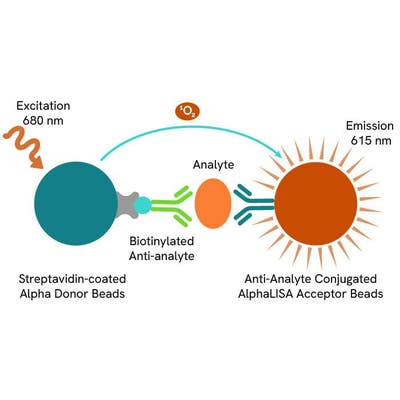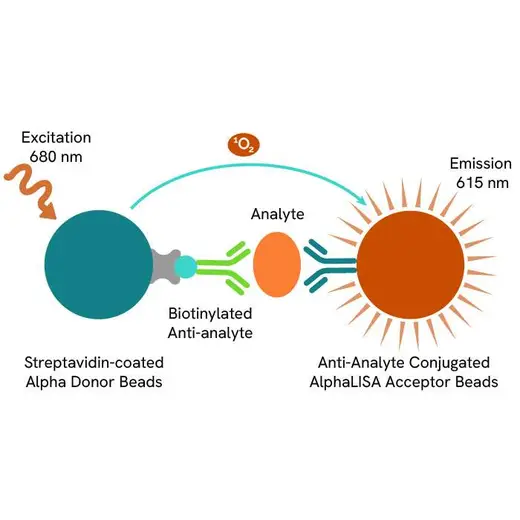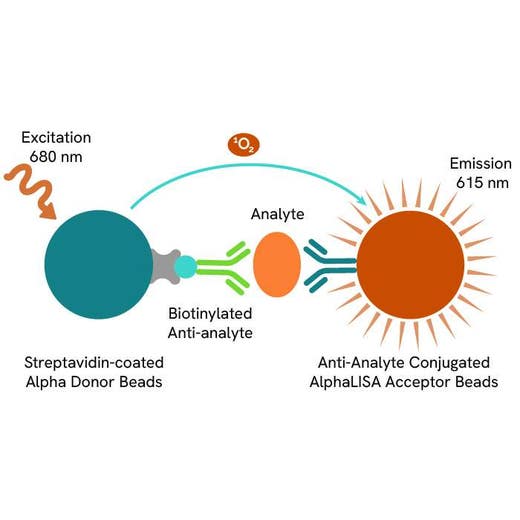
AlphaLISA Human CXCL10 High Performance Detection Kit, 100 Assay Points


AlphaLISA Human CXCL10 High Performance Detection Kit, 100 Assay Points






The AlphaLISA™ High Performance (HP) Human CXCL10 Detection Kit is designed for the quantitative determination of human CXCL10 in serum, buffered solution, or cell culture medium using a homogeneous (no wash steps, no separation steps) assay.
This kit is the new and improved version of part number AL259.
| Feature | Specification |
|---|---|
| Application | Protein Quantification |
| Dynamic Range | 1.56 - 100,000 pg/mL |
| Limit of Detection | 1.56 pg/mL |
| Limit of Quantification | 5.08 pg/mL |
| Sample Volume | 10 µL |
The AlphaLISA™ High Performance (HP) Human CXCL10 Detection Kit is designed for the quantitative determination of human CXCL10 in serum, buffered solution, or cell culture medium using a homogeneous (no wash steps, no separation steps) assay.
This kit is the new and improved version of part number AL259.



AlphaLISA Human CXCL10 High Performance Detection Kit, 100 Assay Points



AlphaLISA Human CXCL10 High Performance Detection Kit, 100 Assay Points



Product information
Overview
C-X-C Motif Chemokine 10 (CXCL10), also known as 10 kDa Interferon-gamma-Induced protein (IP-10), is a 77 amino acid protein secreted by several cell types in response to IFNγ. These cell types include monocytes, endothelial cells, and fibroblasts. CXCL10 holds several roles such as chemoattraction for monocytes, T-cells, and dendritic cells. Other activities include promotion of T-cell adhesion to endothelial cells, antitumor activity, and inhibition of bone marrow colony formation. It has been suggested that CXCL10 plays an important role in delayed hypersensitivity reactions. Increased levels of CXCL10 are found in psoriatic plaques characterized by the infiltration of neutrophils, but it does not activate neutrophils. It was reported that CXCL10 also possesses antimicrobial activity. Recent data suggest that CXCL10 could bind to toll-like receptor 4 and may contribute to beta cell failure in diabetes.
Formats
- Our 100 assay point kit allows you to run 100 wells in 96-well format, using a 100 µL reaction volume (10 µL of sample).
- Our 500 assay point kit allows you to run 500 wells in 96-well or 384-well format, using a 50 µL reaction volume (5 µL of sample).
- Our 5,000 assay point kit allows you to run 5,000 wells in 96-well or 384-well format, using a 50 µL reaction volume (5 µL of sample).
Features
- No-wash steps, no separation steps
- ELISA alternative technology
- Sensitive detection
- Broad sample compatibility
- Small sample volume
- Results in less than 3 hours
- Half the time of an ELISA assay
AlphaLISA technology allows the detection of molecules of interest in a no-wash, highly sensitive, quantitative assay. In an AlphaLISA assay, a biotinylated anti-analyte antibody binds to the Streptavidin-coated Donor beads while another anti-analyte antibody is conjugated to AlphaLISA Acceptor beads. In the presence of the analyte, the beads come into close proximity. The excitation of the Donor beads causes the release of singlet oxygen molecules that triggers a cascade of energy transfer in the Acceptor beads, resulting in a sharp peak of light emission at 615 nm.
Specifications
| Application |
Protein Quantification
|
|---|---|
| Automation Compatible |
Yes
|
| Brand |
AlphaLISA
|
| Detection Modality |
Alpha
|
| Dynamic Range |
1.56 - 100,000 pg/mL
|
| Limit of Detection |
1.56 pg/mL
|
| Limit of Quantification |
5.08 pg/mL
|
| Product Group |
Kit
|
| Sample Volume |
10 µL
|
| Shipping Conditions |
Shipped in Blue Ice
|
| Target |
CXCL10
|
| Target Class |
Cytokines
|
| Target Species |
Human
|
| Technology |
Alpha
|
| Therapeutic Area |
Autoimmunity
Immuno-oncology
Oncology
|
| Unit Size |
100 Assay Points
|
Video gallery

AlphaLISA Human CXCL10 High Performance Detection Kit, 100 Assay Points

AlphaLISA Human CXCL10 High Performance Detection Kit, 100 Assay Points

Resources
Are you looking for resources, click on the resource type to explore further.
Our R&D scientists were determined to enable your research by developing new and improved versions of our AlphaLISA cytokine...
Cytokines play a vital role in both innate and adaptive immunity and are known for their ability to exert diverse functions on...
Advance your autoimmune disease research and benefit from Revvity broad offering of reagent technologies


How can we help you?
We are here to answer your questions.






























